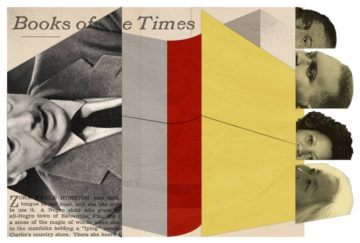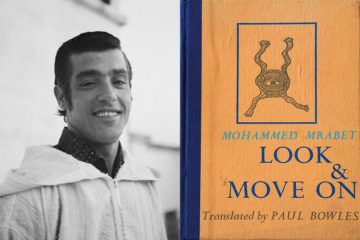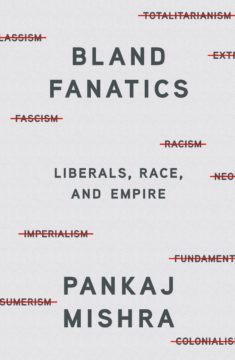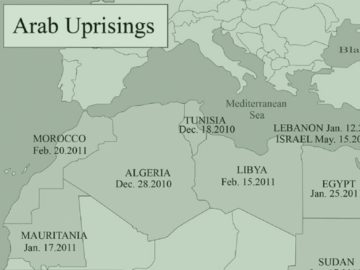Category: Recommended Reading
From Devout Christianity to UFOs
Jenny Valentish at The Guardian:
 The Believer is the highly anticipated second book from Sarah Krasnostein, author of multi-award-winning The Trauma Cleaner. She immerses herself in the worlds of UFO chasers, paranormal investigators, Creationists, Mennonites, a woman whose belief in God is steadfast despite having been let down by the criminal justice system, and a death doula (essentially a midwife for dying).
The Believer is the highly anticipated second book from Sarah Krasnostein, author of multi-award-winning The Trauma Cleaner. She immerses herself in the worlds of UFO chasers, paranormal investigators, Creationists, Mennonites, a woman whose belief in God is steadfast despite having been let down by the criminal justice system, and a death doula (essentially a midwife for dying).
The book is split into two parts, with three stories alternating in each, but it does not have the sudden, satisfying synchronicities that you might expect from such a format. Rather, it’s a philosophical meditation on all aspects of faith and self-delusion, with the elegant phrasing of ideas that made The Trauma Cleaner such a delight.
more here.
Reviewing the Book Review
Parul Sehgal at the NYT:
 To wander through 125 years of book reviews is to endure assault by adjective. All the fatuous books, the frequently brilliant, the disappointing, the essential. The adjectives one only ever encounters in a review (indelible, risible), the archaic descriptors (sumptuous). So many masterpieces, so many duds — now enjoying quiet anonymity.
To wander through 125 years of book reviews is to endure assault by adjective. All the fatuous books, the frequently brilliant, the disappointing, the essential. The adjectives one only ever encounters in a review (indelible, risible), the archaic descriptors (sumptuous). So many masterpieces, so many duds — now enjoying quiet anonymity.
What did I find? Those misjudged masterpieces — on Dreiser’s “Sister Carrie”: “It is a book one can very well get along without reading.” The sensitive assessments — consistently by the critic and former editor of the Book Review, John Leonard, an early and forceful champion of writers like Toni Morrison, John Edgar Wideman and Grace Paley. Fluorescent condescension and stereotype — on N. Scott Momaday’s “House Made of Dawn,” which went on to win the 1969 Pulitzer Prize for fiction: “American Indians do not write novels and poetry as a rule or teach English in top-ranking universities either. But we cannot be patronizing.” Oh, no?
more here.
Saturday Poem
— An original poem written for the inaugural reading of
Poet Laureate Tracy K. Smith at the Library of Congress.
In This Place
There’s a poem in this place—
in the footfalls in the halls
in the quiet beat of the seats.
It is here, at the curtain of day,
where America writes a lyric
you must whisper to say.
There’s a poem in this place—
in the heavy grace,
the lined face of this noble building,
collections burned and reborn twice.
There’s a poem in Boston’s Copley Square
where protest chants
tear through the air
like sheets of rain,
where love of the many
swallows hatred of the few.
There’s a poem in Charlottesville
where tiki torches string a ring of flame
tight round the wrist of night
where men so white they gleam blue—
seem like statues
where men heap that long wax burning
ever higher
where Heather Heyer
blooms forever in a meadow of resistance.
There’s a poem in the great sleeping giant
of Lake Michigan, defiantly raising
its big blue head to Milwaukee and Chicago—
a poem begun long ago, blazed into frozen soil,
strutting upward and aglow.
There’s a poem in Florida, in East Texas
where streets swell into a nexus
of rivers, cows afloat like mottled buoys in the brown,
where courage is now so common
that 23-year-old Jesus Contreras rescues people from floodwaters.
The French Inquisition
Rafia Zakaria in The Baffler:
 I HAVE NEVER FELT WELCOME in France. From the sneer on the face of the immigration officer stamping my passport, to the in-your-face staring of black-clad middle-aged women on the metro, to the standoffish workers in Parisian bakeries—it all adds up to a collective face-palm. They’re forced to let me into the country because of my magical American passport, but that doesn’t mean they have to be nice about it. I know the reason; traveling to France and being treated well is yet another exercise of white privilege, one open to all the fresh-faced English and French majors at American universities, and all the social-climbing women hoping to live some version of the I-found-a-French-lover/bakery/apartment-that-I-cannot-live-without. It’s not easy to explain to these uncritical consumers of a Fantasy France that the country is a racist and bigoted hell for those born sans white privilege. Americans have invested a great deal in anointing the trip to Paris as a ritual that endows the taker with the chic they so desire.
I HAVE NEVER FELT WELCOME in France. From the sneer on the face of the immigration officer stamping my passport, to the in-your-face staring of black-clad middle-aged women on the metro, to the standoffish workers in Parisian bakeries—it all adds up to a collective face-palm. They’re forced to let me into the country because of my magical American passport, but that doesn’t mean they have to be nice about it. I know the reason; traveling to France and being treated well is yet another exercise of white privilege, one open to all the fresh-faced English and French majors at American universities, and all the social-climbing women hoping to live some version of the I-found-a-French-lover/bakery/apartment-that-I-cannot-live-without. It’s not easy to explain to these uncritical consumers of a Fantasy France that the country is a racist and bigoted hell for those born sans white privilege. Americans have invested a great deal in anointing the trip to Paris as a ritual that endows the taker with the chic they so desire.
In the past several decades, but particularly in the past few months, France’s two-faced truths have been exposed in all their grimace-inducing reality. On February 16, the French National Assembly passed a bill, originally termed the “anti-separatism” law, that would allow the state to intervene and shut down any religious or community organization that it found wanting in its commitment to French secularism. The legislation, which is now under consideration in the Senate, mandates further scrutiny of homeschooling—a method many French Muslims have resorted to so as to educate girls who are not permitted to attend regular school because they wear the headscarf. The legislation will bolster the French state’s ability to impose its version of secularism—what they call laïcité—on everyone they dislike. France’s Muslims, who make up about 8 percent of the population and are widely stigmatized as being potential terrorists, are the targets. Absent entirely are any plans for the French state to confront how racism contributes to religious violence in France.
More here.
Ten Little Known Black History Facts
From PBS:
 In an effort to honor this expansive and growing history, Black History Month was established by way of a weekly celebration in February known as “Negro History Week” by historian Carter G. Woodson. But just as Black history is more than a month, so too are the numerous events and figures that are often overlooked during it. What follows is a list of some of those “lesser known” moments and facts in Black history.
In an effort to honor this expansive and growing history, Black History Month was established by way of a weekly celebration in February known as “Negro History Week” by historian Carter G. Woodson. But just as Black history is more than a month, so too are the numerous events and figures that are often overlooked during it. What follows is a list of some of those “lesser known” moments and facts in Black history.
Of the 12.5 million Africans shipped to the New World during the Transatlantic Slave Trade, fewer than 388,000 arrived in the United States.
In the late 15th century, the advancement of seafaring technologies created a new Atlantic that would change the world forever. As ships began connecting West Africa with Europe and the Americas, new fortunes were sought and native populations were decimated. With the native labor force dwindling and demand for plantation and mining labor growing, the transatlantic slave trade began. The Transatlantic Slave Trade was underway from 1500-1866, shipping more than 12 million African slaves across the world. Of those slaves, only 10.7 million survived the dreaded Middle Passage. Over 400 years, the majority of slaves (4.9 million) found their way to Brazil where they suffered incredibly high mortality rates due to terrible working conditions. Brazil was also the last country to ban slavery in 1888. By the time the United States became involved in the slave trade, it had been underway for two hundred years. The majority of its 388,000 slaves arrived between 1700 and 1866, representing a much smaller percentage than most Americans realize.
More here. (Throughout February, at least one post will be dedicated to honoring Black History Month. The theme this year is: The Family)
Friday, February 26, 2021
J.K. Rowling
Thank You, Lawrence Ferlinghetti
Alysia Abbott at Literary Hub:

When Lawrence Ferlinghetti died this week at age 101, nearly one month shy his 102nd birthday, many of my friends, even writer friends, expressed surprise on social media. I didn’t even know he was still alive!
Indeed, Ferlinghetti outlived all the younger Beat writers he once published including Jack Kerouac, William Burroughs, Allen Ginsberg, and Greg Corso. When The New York Times, in a 2005 interview, asked him why, he answered, “Kerouac drank himself to death, and Burroughs, when he was young, thought the healthiest person was one who had enough money to stay on heroin all his life. I really never got into drugs. I smoked a little dope, and I did a little LSD, but that was it. I was afraid of it, frankly. I don’t like to be out of control.”
But for me, and a segment of San Franciscans and aspiring bohemians worldwide, Ferlinghetti seemed immortal; we found comfort in this.
more here.
The Storyteller of Tangier
Lucy Scholes at The Paris Review:
 Like many readers, I suspect, I first came across the name Mohammed Mrabet in relation to Paul Bowles. Throughout the sixties, seventies, and eighties, everyone from Life magazine to Rolling Stone sent writers and photographers to Tangier—where Bowles had been living since 1947—to interview the famous American expat, author of the cult classic The Sheltering Sky. “If Paul Bowles, now seventy-four, were Japanese, he would probably be designated a Living National Treasure; if he were French, he would no doubt be besieged by television crews from the literary talk show Apostrophes,” wrote Jay McInerney in one such piece for Vanity Fair in 1985. “Given that he is American, we might expect him to be a part of the university curriculum, but his name rarely appears in a course syllabus. Perhaps because he is not representative of a particular period or school of writing, he remains something of a trade secret among writers.” This wasn’t to say that Bowles was reclusive. In fact, he kept open house for one and all, whether they be curious tourists, his famous friends—Tennessee Williams, William S. Burroughs, and Allen Ginsberg among them—or the crowd of Moroccan storytellers and artists he’d befriended over the years. And of these, one man in particular stands out: Mohammed Mrabet.
Like many readers, I suspect, I first came across the name Mohammed Mrabet in relation to Paul Bowles. Throughout the sixties, seventies, and eighties, everyone from Life magazine to Rolling Stone sent writers and photographers to Tangier—where Bowles had been living since 1947—to interview the famous American expat, author of the cult classic The Sheltering Sky. “If Paul Bowles, now seventy-four, were Japanese, he would probably be designated a Living National Treasure; if he were French, he would no doubt be besieged by television crews from the literary talk show Apostrophes,” wrote Jay McInerney in one such piece for Vanity Fair in 1985. “Given that he is American, we might expect him to be a part of the university curriculum, but his name rarely appears in a course syllabus. Perhaps because he is not representative of a particular period or school of writing, he remains something of a trade secret among writers.” This wasn’t to say that Bowles was reclusive. In fact, he kept open house for one and all, whether they be curious tourists, his famous friends—Tennessee Williams, William S. Burroughs, and Allen Ginsberg among them—or the crowd of Moroccan storytellers and artists he’d befriended over the years. And of these, one man in particular stands out: Mohammed Mrabet.
more here.
What “weird Catholicism” reveals about the language of the internet
Justin E. H. Smith in the New Statesman:
 When the New York Times Magazine ran its profile of the “Weird Catholic Twitter” (WCT) community in May 2020, extremely-online Catholics and non-Catholics alike came together in one of the internet’s periodic gestures of widespread, synchronised eye-rolling. One well-known Twitter personality, Connor Wroe Southard, wrote that this exposé was akin to the same newspaper’s description of the alt-right YouTuber Ben Shapiro as “the cool kid’s philosopher”. Another familiar voice of Twitter, Liz Franczak, exclaimed in a rawer spirit: “I cannot believe there is a Weird Catholic Twitter piece in nytmag.”
When the New York Times Magazine ran its profile of the “Weird Catholic Twitter” (WCT) community in May 2020, extremely-online Catholics and non-Catholics alike came together in one of the internet’s periodic gestures of widespread, synchronised eye-rolling. One well-known Twitter personality, Connor Wroe Southard, wrote that this exposé was akin to the same newspaper’s description of the alt-right YouTuber Ben Shapiro as “the cool kid’s philosopher”. Another familiar voice of Twitter, Liz Franczak, exclaimed in a rawer spirit: “I cannot believe there is a Weird Catholic Twitter piece in nytmag.”
The general consensus was that the NYT, as a vehicle of mainstream liberal ideology, was late to the scene, and was corrupting the nature of the thing it was seeking to report on for a larger audience, as has always happened when a subcultural trend gains mainstream attention. But the arrival of WCT in such a venue also brought to a wider public a familiar lesson: that in the era of social media no institution, not even the ones most defiantly removed from the shifting winds of fashion, can entirely avoid getting weird. Everything is getting weird, even the church built upon a rock.
My interest here is personal. I am Catholic, but in a weird and uncertain way.
More here.
Artificial Neural Nets Finally Yield Clues to How Brains Learn
Anil Ananthaswamy in Quanta:
 In 2007, some of the leading thinkers behind deep neural networks organized an unofficial “satellite” meeting at the margins of a prestigious annual conference on artificial intelligence. The conference had rejected their request for an official workshop; deep neural nets were still a few years away from taking over AI. The bootleg meeting’s final speaker was Geoffrey Hinton of the University of Toronto, the cognitive psychologist and computer scientist responsible for some of the biggest breakthroughs in deep nets. He started with a quip: “So, about a year ago, I came home to dinner, and I said, ‘I think I finally figured out how the brain works,’ and my 15-year-old daughter said, ‘Oh, Daddy, not again.’”
In 2007, some of the leading thinkers behind deep neural networks organized an unofficial “satellite” meeting at the margins of a prestigious annual conference on artificial intelligence. The conference had rejected their request for an official workshop; deep neural nets were still a few years away from taking over AI. The bootleg meeting’s final speaker was Geoffrey Hinton of the University of Toronto, the cognitive psychologist and computer scientist responsible for some of the biggest breakthroughs in deep nets. He started with a quip: “So, about a year ago, I came home to dinner, and I said, ‘I think I finally figured out how the brain works,’ and my 15-year-old daughter said, ‘Oh, Daddy, not again.’”
The audience laughed. Hinton continued, “So, here’s how it works.” More laughter ensued.
Hinton’s jokes belied a serious pursuit: using AI to understand the brain. Today, deep nets rule AI in part because of an algorithm called backpropagation, or backprop. The algorithm enables deep nets to learn from data, endowing them with the ability to classify images, recognize speech, translate languages, make sense of road conditions for self-driving cars, and accomplish a host of other tasks.
More here.
Glenn Greenwald on Trending as a Transphobe and Biphobe
Pankaj Mishra’s Reckoning With Liberalism’s Bloody Past
Kanishk Tharoor in The New Republic:
 For nearly three decades, Mishra has skewered the pieties of politicians and intellectuals in the Anglophone world (including India, which boasts more English speakers than the United Kingdom), while also bringing his spirited attention to the histories and imaginations of people outside circles of wealth and power. The scales first fell from his eyes during his travels and reporting in Kashmir in the late 1990s and early 2000s. In the disputed Indian-administered territory, he saw firsthand the collision between India’s pluralist liberal democracy—its avowed commitment to democratic norms, individual rights, and multiculturalism—and the reality of military occupation. Indian apologia for abuses in Kashmir, he writes, “prepared me for the spectacle of a liberal intelligentsia cheerleading the war for ‘human rights’ in Iraq, with the kind of humanitarian rhetoric about freedom, democracy and progress that was originally heard from European imperialists in the nineteenth century.” The remit of Mishra’s work has grown steadily wider over the decades, from an early focus on the dreams and catastrophes of small-town India, to a thoughtful exploration of colonial-era Asian intellectual history in the excellent From the Ruins of Empire (2012), to the sweeping global jurisdiction of his recent books, which directly confront the international order made by the United Kingdom and the United States.
For nearly three decades, Mishra has skewered the pieties of politicians and intellectuals in the Anglophone world (including India, which boasts more English speakers than the United Kingdom), while also bringing his spirited attention to the histories and imaginations of people outside circles of wealth and power. The scales first fell from his eyes during his travels and reporting in Kashmir in the late 1990s and early 2000s. In the disputed Indian-administered territory, he saw firsthand the collision between India’s pluralist liberal democracy—its avowed commitment to democratic norms, individual rights, and multiculturalism—and the reality of military occupation. Indian apologia for abuses in Kashmir, he writes, “prepared me for the spectacle of a liberal intelligentsia cheerleading the war for ‘human rights’ in Iraq, with the kind of humanitarian rhetoric about freedom, democracy and progress that was originally heard from European imperialists in the nineteenth century.” The remit of Mishra’s work has grown steadily wider over the decades, from an early focus on the dreams and catastrophes of small-town India, to a thoughtful exploration of colonial-era Asian intellectual history in the excellent From the Ruins of Empire (2012), to the sweeping global jurisdiction of his recent books, which directly confront the international order made by the United Kingdom and the United States.
More here.
Friday Poem
Self-Portrait
Between the computer, a pencil, and a typewriter
half my day passes. One day it will be half a century.
I live in strange cities and sometimes talk
with strangers about matters strange to me.
I listen to music a lot: Bach, Mahler, Chopin, Shostakovich.
I see three elements in music: weakness, power, and pain.
The fourth has no name.
I read poets, living and dead, who teach me
tenacity, faith, and pride. I try to understand
the great philosophers–but usually catch just
scraps of their precious thoughts.
I like to take long walks on Paris streets
and watch my fellow creatures, quickened by envy,
anger, desire; to trace a silver coin
passing from hand to hand as it slowly
loses its round shape (the emperor’s profile is erased).
Beside me trees expressing nothing
but a green, indifferent perfection.
Black birds pace the fields,
waiting patiently like Spanish widows.
I’m no longer young, but someone else is always older.
I like deep sleep, when I cease to exist,
and fast bike rides on country roads when poplars and houses
dissolve like cumuli on sunny days.
Sometimes in museums the paintings speak to me
and irony suddenly vanishes.
I love gazing at my wife’s face.
Every Sunday I call my father.
Every other week I meet with friends,
thus proving my fidelity.
My country freed itself from one evil. I wish
another liberation would follow.
Could I help in this? I don’t know.
I’m truly not a child of the ocean,
as Antonio Machado wrote about himself,
but a child of air, mint and cello
and not all the ways of the high world
cross paths with the life that–so far–
belongs to me.
by Adam Zagajewski
translated by Clare Cavanagh
Between the Lines: Seeking solace in the work of the fourteenth-century Persian poet Hafez
Nilo Tabrizy in Guernica:
 I wouldn’t wish being Iranian on my worst enemy,” my friend Marjan posted on Instagram in mid-January.
I wouldn’t wish being Iranian on my worst enemy,” my friend Marjan posted on Instagram in mid-January.
Like many Iranians, Marjan is stuck in visa limbo. An economics professor in New York, she traveled to Iran in August of last year, and by the time her return visa was finally issued, coronavirus restrictions meant she was stuck in Iran. But her post was about more than just travel frustrations. From individual experiences to our collective story, the past nine months have been a painful series of run-on tragedies for Iranians: November 2019 saw nation-wide demonstrations where state security forces killed 1,500 protesters. In January, the US government ordered a targeted killing of Iran’s top military general, and Iran responded with a missile strike on a US military base in Iraq. Days later, the Revolutionary Guards (IRGC) downed a civilian airliner, killing 176 passengers and crewmembers in the midst of the escalated tension of war. And then in February, the coronavirus crisis. It’s been all-consuming. I cover Iran in video for the New York Times, and spent January tracking down and interviewing eyewitnesses in Iran who saw the plane crash, while dealing with the trauma of reporting on a story that impacted me deeply, as a member of the Iranian-Canadian community.
I was born in Tehran during the turbulent beginnings of the nascent Islamic Republic. Iran was rebuilding after the 1979 revolution, which ended centuries of monarchy and installed a then-popularly backed Islamic government. But the revolution was quickly followed by a brutal eight-year war with Iraq.
More here.
23 Black leaders who are shaping history today
Courtney Connley in Make it:
 Black Americans have played a crucial role in helping to advance America’s business, political and cultural landscape into what it is today. And since 1976, every U.S. president has designated the month of February as Black History Month to honor the achievements and the resilience of the Black community. While CNBC Make It recognizes that Black history is worth being celebrated year-round, we are using this February to shine a special spotlight on 23 Black leaders whose recent accomplishments and impact will inspire many generations to come. These leaders, who have made history in their respective fields, stand on the shoulders of pioneers who came before them, including Shirley Chisholm, John Lewis, Maya Angelou and Mary Ellen Pleasant.
Black Americans have played a crucial role in helping to advance America’s business, political and cultural landscape into what it is today. And since 1976, every U.S. president has designated the month of February as Black History Month to honor the achievements and the resilience of the Black community. While CNBC Make It recognizes that Black history is worth being celebrated year-round, we are using this February to shine a special spotlight on 23 Black leaders whose recent accomplishments and impact will inspire many generations to come. These leaders, who have made history in their respective fields, stand on the shoulders of pioneers who came before them, including Shirley Chisholm, John Lewis, Maya Angelou and Mary Ellen Pleasant.
Following the lead of trailblazers throughout American history, today’s Black history-makers are shaping not only today but tomorrow. From helping to develop a Covid-19 vaccine, to breaking barriers in the White House and in the C-suite, below are 23 Black leaders who are shattering glass ceilings in their wide-ranging roles.
More here. (Throughout February, at least one post will be dedicated to honoring Black History Month. The theme this year is: The Family)
Thursday, February 25, 2021
Ten Years of Hope and Blood
Robert Solé in The Markaz Review:
 It is in the middle of winter that the “Arab Spring” comes unexpectedly. On December 17, 2010, in Sidi Bouzid, an agricultural village in central Tunisia, Mohamed Bouazizi, a young unemployed peddler, sets himself on fire after his merchandise is confiscated by police officers. The day after the tragedy, the anger spreads to other cities in the country. President Zine el-Abidine Ben Ali, who has been in power for twenty-three years, denounces “terrorist acts” perpetrated by “hooded thugs.” The deaths will soon be counted by the dozens during clashes with the forces of law and order. “Irhal!” (“leave”) becomes the revolution’s byword. Ben Ali is accused not only of having established a police regime, but also of pillaging Tunisia. On January 14, 2011, overwhelmed by the events, he flees with his family to Saudi Arabia.
It is in the middle of winter that the “Arab Spring” comes unexpectedly. On December 17, 2010, in Sidi Bouzid, an agricultural village in central Tunisia, Mohamed Bouazizi, a young unemployed peddler, sets himself on fire after his merchandise is confiscated by police officers. The day after the tragedy, the anger spreads to other cities in the country. President Zine el-Abidine Ben Ali, who has been in power for twenty-three years, denounces “terrorist acts” perpetrated by “hooded thugs.” The deaths will soon be counted by the dozens during clashes with the forces of law and order. “Irhal!” (“leave”) becomes the revolution’s byword. Ben Ali is accused not only of having established a police regime, but also of pillaging Tunisia. On January 14, 2011, overwhelmed by the events, he flees with his family to Saudi Arabia.
Five days later, as protests erupted in Jordan, Yemen and Lebanon, and firebombings were reported in Algeria, Egypt and Mauritania, an Arab League summit was convened in Sharm el-Sheikh, South Sinai. For once, its secretary general, Amr Moussa abandons the language of wood. “Arab citizens,” he declares, “are in a state of unprecedented anger and frustration.”
More here.
Why “Trusting the Science” Is Complicated
Suman Seth in the Los Angeles Review of Books:
 It is possible that John Pringle’s neighbors viewed him with some distaste. Formerly physician-general to the British forces in the Low Countries, in 1749 Pringle had settled down in a rather swanky part of London, where he began investigating the processes behind putrefaction. He would place pieces of beef in a lamp furnace, sometimes combining them with another substance — and then wait for putrefaction to commence, or not. Falsifying an earlier hypothesis, Pringle showed that not only acids but alkalis, like baker’s ammonia, could retard the progress of decay. Even more impressively, some substances, like Peruvian bark (source of the malarial prophylactic, quinine) could outright reverse putrefaction, rendering tainted meat seemingly edible again.
It is possible that John Pringle’s neighbors viewed him with some distaste. Formerly physician-general to the British forces in the Low Countries, in 1749 Pringle had settled down in a rather swanky part of London, where he began investigating the processes behind putrefaction. He would place pieces of beef in a lamp furnace, sometimes combining them with another substance — and then wait for putrefaction to commence, or not. Falsifying an earlier hypothesis, Pringle showed that not only acids but alkalis, like baker’s ammonia, could retard the progress of decay. Even more impressively, some substances, like Peruvian bark (source of the malarial prophylactic, quinine) could outright reverse putrefaction, rendering tainted meat seemingly edible again.
In 1752, Pringle used these results to make medical recommendations in a book entitled Diseases of the Army. Rot within the body, he asserted, accounted for a great many diseases afflicting soldiers in particular. It followed that substances that could slow down or reverse putrefaction could also — when swallowed — combat these diseases.
More here.
Yanis Varoufakis: Capitalism has become ‘techno-feudalism’
How Law Made Neoliberalism
Jedediah Britton-Purdy, Amy Kapczynski, and David Singh Grewal in the Boston Review:
 We live in an era of intersecting crises—some new, some old but newly visible. At the time of writing, the COVID-19 pandemic has already caused nearly 500,000 deaths in the United States alone, with many more deaths on the horizon in the coming months. Since its arrival in the United States, the virus has intersected with and magnified long-neglected problems—radical disparities in access to healthcare and the fulfillment of basic needs that disproportionately impact communities of color and working-class Americans, alongside a crisis of care for the young, elderly, and sick that stretches families and communities to the breaking point.
We live in an era of intersecting crises—some new, some old but newly visible. At the time of writing, the COVID-19 pandemic has already caused nearly 500,000 deaths in the United States alone, with many more deaths on the horizon in the coming months. Since its arrival in the United States, the virus has intersected with and magnified long-neglected problems—radical disparities in access to healthcare and the fulfillment of basic needs that disproportionately impact communities of color and working-class Americans, alongside a crisis of care for the young, elderly, and sick that stretches families and communities to the breaking point.
These crises arise from the chronic failure of political institutions to respond democratically to public needs. They are rooted in decades of politics, policy, and law. For many Black, brown, rural, indigenous, and working-class Americans, this democratic failure is business as usual. But over the last four years, and especially since the storming of the Capitol, fear of democratic failure has become mainstream.
These crises are often analyzed in terms of the political economy of neoliberalism, an ideology of governance that came to predominate in the 1970s and ’80s. Neoliberalism is associated with a demand for deregulation, austerity, and an attempt to assimilate government to something more like a market—but it never was as simple as a demand for “free markets.” Rather, it was a demand to protect the market from democratic demands for redistribution.
More here.
